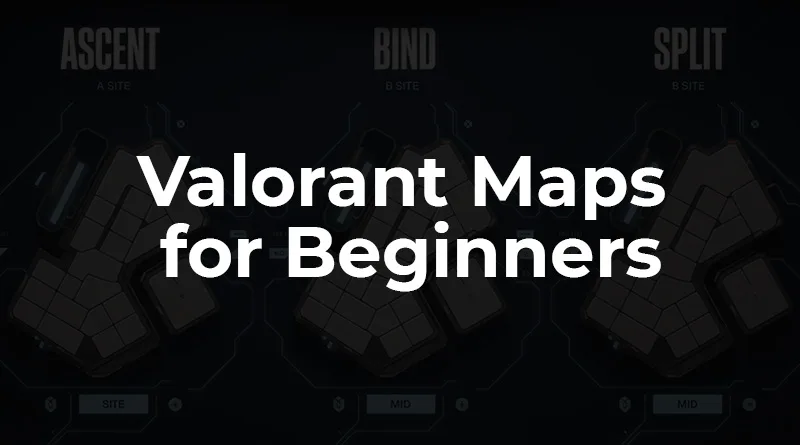You’ve picked your agent, you’ve dialed in your crosshair, and you’re ready to play. You load into a match and… you’re completely lost. Where are the sites? What’s a “Heaven”? Why is your team yelling “They’re rotating B Long!”? Understanding the battlefield is just as important as winning your gunfights.
Feeling lost on the different Valorant maps for beginners is the most common hurdle for new players. This guide is your introduction to the topic. We won’t overwhelm you, but will instead break down three classic maps to teach the core concepts of layouts and callouts. Mastering Valorant maps for beginners is a huge part of learning how to rank up in Valorant.
Table of Contents
Core Concepts: Attackers, Defenders, and Callouts
Understanding the different Valorant maps for beginners starts with a few basic principles that apply to every map in the game.
- Attackers: Your team’s goal is to plant the Spike at one of the designated “Sites” (usually A, B, or C).
- Defenders: Your team’s goal is to prevent the Attackers from planting the Spike, or to defuse it if they do.
- Callouts: These are simple, standardized names for specific locations on a map. Using them allows you to give your team precise information quickly (e.g., “Jett is in Heaven,” instead of “Jett is in that high-up spot on A site”).
A Guide to Valorant Maps for Beginners: Layouts and Callouts
Let’s dive into three maps that will teach you everything you need to know to get started.
1. Ascent: The Classic Two-Site Map
Ascent is often considered the most standard, balanced map in Valorant. It has two sites, A and B, and a highly contested Mid (middle) area. Control of Mid is often the key to winning the round.
(Insert Image of Ascent Map Layout Here)
Image Alt Text: The map layout for Ascent, a key part of our guide to Valorant maps for beginners.
Essential Ascent Callouts:
- A Main / B Main: The primary corridors that Attackers use to approach the A and B sites.
- Mid: The large, open central area of the map. It’s divided into “Mid Courtyard,” “Mid Top,” and “Mid Link.”
- Heaven: A general term for any elevated position overlooking a site. On Ascent, both A and B sites have a “Heaven” area.
- Hell: A term for the area directly underneath a “Heaven.”
2. Bind: No Mid, Just Teleporters
Bind is unique because it has no middle lane. Instead, it features two one-way teleporters that allow for fast rotations between the A and B sites.
(Insert Image of Bind Map Layout Here)
Image Alt Text: The map layout for Bind, showing the teleporters, a focus of our Valorant maps for beginners guide.
Essential Bind Callouts:
- A Short / B Short: The shorter paths to the sites. A Short is also called “Showers” because of the small bathroom area.
- A Long / B Long: The longer, more open paths to the sites.
- Lamps: The room on A site that players can enter from A Short.
- Hookah: The room with large windows that Attackers push through to get to B site.
- TP / Teleporter: Used to call out that an enemy has used the teleporter (“Heard TP!”).
3. Split: All About Verticality
Split is defined by its extreme verticality, with ropes and high-ground positions playing a huge role. It has a contested Mid area that leads up to the “Heaven” positions overlooking both bombsites.
(Insert Image of Split Map Layout Here)
Image Alt Text: The map layout for Split, highlighting its verticality for our Valorant maps for beginners guide.
Essential Split Callouts:
- Mid: The central area connecting the Attacker and Defender spawns.
- Vents / Ropes: The ropes that allow players to quickly move between Mid and A Heaven.
- A Heaven / B Heaven: The elevated structures that overlook both the A and B sites. These are the most powerful positions on the map.
- Rafters: The beams inside A Heaven.
- Screens: The area at the back of B site with large screens.
Agent Choice and Map Strategy
As you learn the maps, you’ll see how certain agents excel in specific environments.
- A Sentinel agent like Killjoy or Sage is fantastic on a map like Split, where they can use their abilities to lock down one of the tight chokepoints.
- An Initiator like Sova is a huge asset on Ascent, where his Recon Bolt can clear large, open areas for his team.
How to Learn Faster
You don’t need to memorize every callout overnight. The process of learning Valorant maps for beginners is all about experience, and the best way to learn is by playing.
- Focus on One Map: When you’re new, don’t try to learn all the maps at once. Focus on learning the callouts for one map, like Ascent.
- Keep Comms On: Listen to what your teammates are saying. When you die, look at the minimap and connect the name they called out with the location where you died.
- Use Custom Games: Load into a custom game by yourself and just run around the maps. It’s a no-pressure way to explore all the corners and angles.
Learning Valorant maps for beginners takes time, but it’s one of the most rewarding skills you can develop. Good map knowledge will win you more rounds than flashy aim ever will. For a complete list of all callouts, the Valorant Wiki is an excellent and detailed resource.

